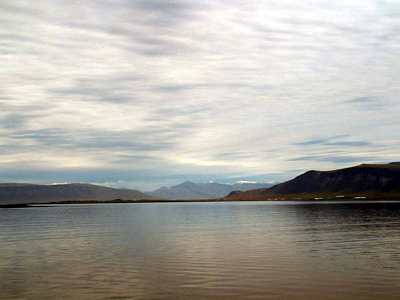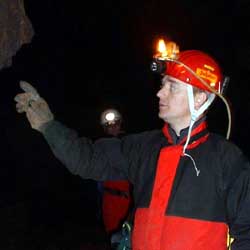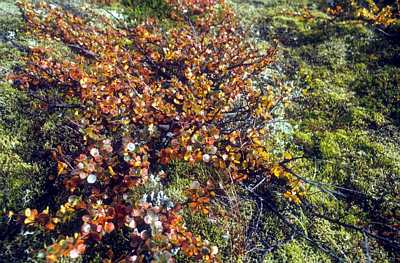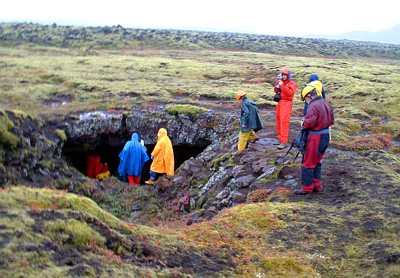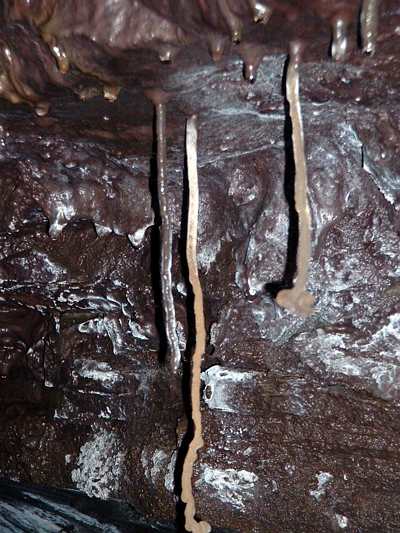The stalagmites, instead, are
the result of blobs of lava falling one on top of another and are reminiscent of
disgusting scenes at the bottom of deep outhouses.
Nine hundred meters inside the
cave, we discovered why it is called Leiðarendi, which means “End of the
Road.” A dead sheep lay on the ground, quite intact but reduced to bones....
The
End of the Road for one unlucky sheep.
|
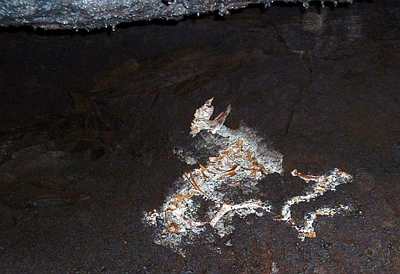 |
..Apparently, even though it found itself inside a long narrow tube, with daylight
rapidly fading, it didn’t have the smarts to turn around and go back out,
preferring to starve to death rather than try something new.
After crawling about in a cold,
wet cave, there’s nothing quite so nice as a dip in a hot spring. But it
wasn’t to some ordinary spa that we went. No, it was Iceland’s world-famous
Blue Lagoon...
A
pleasant soak in the Blue Lagoon as storm clouds gather overhead.
|
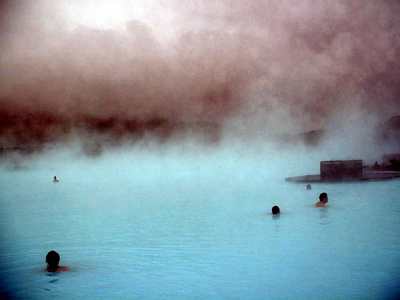 |
..Ah, but what you may not know about it is that these soothing
waters contain the impurities removed from the thermal water that is sent
through pipes to heat homes in this part of Iceland (thus preventing corrosion
in those pipes). Yes, someone discovered that this hot, natural sludge is good
for skin ailments and now people pay to soak in the stuff.
The next two days were devoted
to twenty-minute presentations coming fast one upon the other and overwhelming
somebody like me who am not all that familiar with volcanic matters. However,
some things impressed me and here they are:
-
Icelander Arni B. Stefansson
spoke movingly about the breaking and taking of speleothems from Icelandic
caves. “By 1982, sensitive formations in all known Icelandic caves had been
either severely or totally damaged.” Since that year, gates have been
installed in some of the caves, a step which we cavers in Saudi Arabia still
have not succeeded in accomplishing.
-
The team from the Azores went
even deeper, discussing the fine points of how to rate caves for various
purposes as well as even more esoteric subjects such as a system for expressing
in numbers the rarity of biological species found in their lava tubes.
Meanwhile, in Saudi Arabia, we are still seeking a biologist to take a first
look at the bugs in our tubes!
-
Completely new to me were the megapillows
presented by Francesco Petralia of Italy.
These are huge blobs of lava
which, upon encountering sea water, become inflated by gas expansion and contain
small caves, one example being 14 by 2 meters in size.
A
blurry shot of one of Francesco's slides, showing a megapillow being
inflated by the vaporizing of water which has entered the hot blob.
|
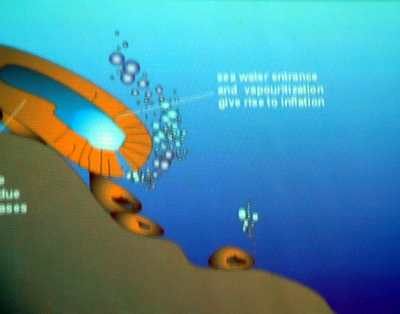 |
-
A similar curiosity are the sub-crustal
drainage lava caves presented by
Ken Grimes of Australia. These can be as simple as a single room or complicated
systems of chambers opening into and dividing into yet more chambers, each
successively drained of lava as the next room is being formed. I suspect that
our Bushy Cave, which we didn’t bother to map for being so small, may be one
of these subcrustal caves: the simplest sort, which is also called a blister
cave.
-
Ken Grimes also described a dyke
cave found in Australia. This formed when the pressure from below ceased and the
lava on the surface of the dyke cooled while the lava below receded slightly. This cave is
17 meters long, about 1.5 meters wide and one meter high with a very small
entrance hole. It would be interesting to search for this kind of cave in KSA.
On Friday there was an all-day
excursion around southwest Iceland. We had the benefit of both Sigurdur and a
professional tour guide and were thus able to learn a lot about the customs of
Iceland as well as its geology. I was particularly surprised to learn that the
average salary in Iceland is $2409 per month and that 38% of people’s income
goes for taxes. It looks like it’s not the average Icelander eating the Big
Macs in this country (which cost ten dollars!).
| On this trip we visited a place
called Geysir where we saw -- you guessed it -- a very famous geyser that can
reach 30 m in height… and, yes, this one is the origin of our word
geyser. Here I learned an interesting fact. If your geyser should someday fail
to go off, you can either wait for the next earthquake, which may turn it back
on, or you can cheat by pouring powdered soap down the geyser’s throat. It
really works, says Siggy.
The
Geysir geyser just beginning to erupt...
|
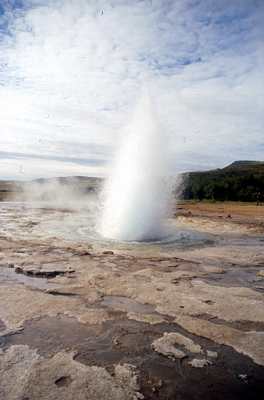 |
| ..Before reaching the cave of the
day, we stopped to see a beautiful waterfall and a “hornito.”
What’s a hornito? Well, it
seems to be a very tiny, splatter-generated volcano, shaped like a pointed hat....
Here
you can see the silhouette of this curious formation with lots of curious
investigators crawling all over it.
|
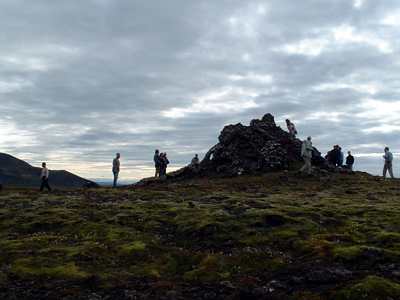 |
The hornito we visited is named Tintron and is about four meters high. There’s a hole in the
top with a deep shaft heading straight down. This was once a lava
channel.
...Finally,
we came to a truly extraordinary cave called
Arnahellir (Hellir, pronounced “hedler” means cave in Icelandic)...
David
Wools-Cobb squeezing through the gate under a cloud of condensation from
our collective breathing.
|
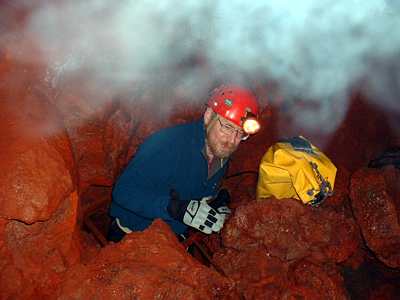 |
...This is a one-room
cave, but every inch is packed with wonderful things to see. Thanks to the efforts of the Icelanders, it is gated
and yellow flagging tape indicates the areas where visitors may not wander.
| Well, I
didn't have a tripod along, so you'll have to bear with this slightly
fuzzy picture. Still, you can see how one could spend hours just to see
this one room.
|
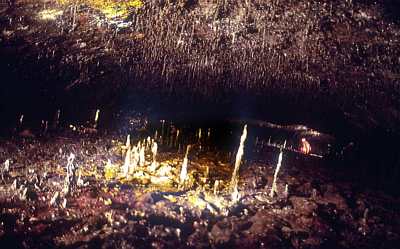 |
...To
help us appreciate the cave fully, the Icelandic cavers actually hauled a
generator all the way to the cave, strung wires and installed a few lights. What
the tape protects is a garden of stalagmites which almost fills the room. They
are tall, skinny, knobby things which look like they were planted by a gnome.
Overhead are long, delicate stalactites. These extend into the area where we
were allowed to walk and it soon became obvious that we had to be extremely
careful at all times to avoid breaking them.
Well, there were nearly 30 of us in
that small area and the roof was low and of varying heights. All this really
stacked the odds against the poor innocent stalactites. And, yes, at least one
was broken – I saw it happen. Well, if that’s how it goes with seasoned
cavers who love lava tubes, what could we expect from a gang of tourists? Speleo
tourism is surely a tricky business.
ICE SUBLIME AND SPARKLING SLIME
I think everybody at the
symposium signed up for the optional excursion on September 15, to Surtshellir
and Viðgelmir Caves. A rather long
bus ride brought us to a lonely dirt road just about the width of our bus. This
road was in pretty bad shape but our bus driver negotiated the ruts, puddles and
holes with cool aplomb as if we were arriving at just another tourist
attraction.
| Surtshellir cave had a big wide
entrance with no gate and we were asked to pick up and carry out as much trash
as we could… and I was amazed at how much garbage had found its way into such
a remote cave.
The moment we passed the
entrance breakdown, we came to a thick, solid floor of ice. This was covered
with a few centimeters of water, creating very slippery conditions, especially
at one or two points where the floor sloped...
|
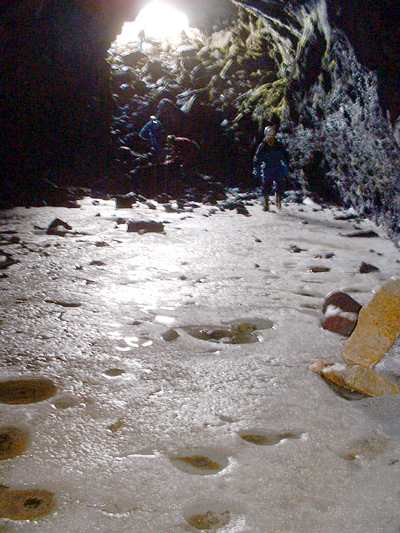 |
A short distance inside the
cave, parts of the ceiling and side walls were covered with what appeared to be
brightly reflective white paint. This I had seen both in Mexican and Saudi
caves. When you draw closer, you discover that the white is actually composed of
countless tiny, separate drops of water. Bill Halliday pointed out that these
drops lie upon a bed of “cave
slime” consisting of a gelatinous layer of bacteria and slime molds. When
removed from the wall, this slime dripped from my finger with the consistency of
watery mucous. I’ve only seen the tiny white drops in caves with pools of
water below, but had never observed whether they were suspended on a coating of
slime, as in this cave.
A little farther into the cave,
we saw the first of many shimmering ice stalagmites. These were of various
thicknesses and sometimes reached waist height.
OK,
I have to admit this is one formation we have yet to find in Saudi caves! |
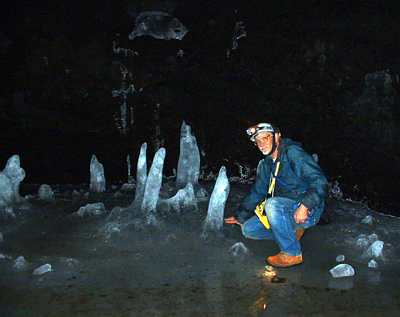 |
No icicles could be seen on the
ceiling and I suppose these ice formations on the floor could have been formed
by simple drops of water falling into a passage in which cold air had settled at
the bottom.
Here's
a mini-grotto, deep inside the cave, shimmering with ice formations.
|
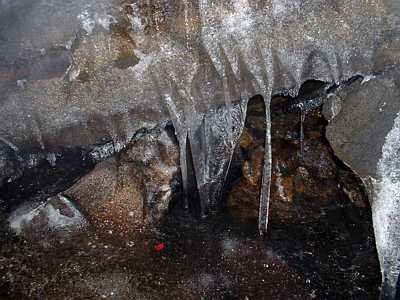 |
OPERATION ICE PICK
Next we came to Viðgelmir,
the largest, but not the longest cave in Iceland. A long breakdown slope leads
into the cave from a huge entrance collapse. At the bottom, you come to a wide
passage whose floor is totally covered with ice.
Surprisingly, this cave, famous
for big passages suddenly gets very low and narrow. Here a gate has been
installed and the owner normally charges an arm and a leg to tourists who, I
suspect, may never get anywhere near the end of the 1585-meter-long cave. I’ll
explain why not in a moment...
|
...Crawling on hands and knees over
the glistening ice floor, we passed through the little gate one by one.
This
is Jan-Paul Van Der Pas, head of the UIS Volcanic Caves Committee,
slip-sliding through the gate.
|
 |
“This tiny passage disappeared
under the ice in 1972,” commented Siggy, "and for 19 years not a soul could
visit Viðgelmir Cave.”
In 1991 members of the Icelandic
Speleological Society steadfastly and patiently chopped their way through the
ice plug and reopened the cave. What are the attractions of Viðgelmir? Well,
once you pass through the gate, the passage opens up wide and there’s a long
stretch of pure white ice, unbroken and gleaming and strongly contrasting with
the dark ceiling and walls.
Then comes the first breakdown
heap. At the edge of it, Siggy led us over to a side wall. He pointed to streams
of pink and chocolate lava that appeared to have oozed out of the walls and run
down them, occasionally dripping to the floor. I understood this was caused by
certain components of the lava cooling more slowly than the larger mass, but a
friend suggested it might simply be an aftermelt, when the floor was still hot
enough to slightly remelt the surface of the side walls. Whatever the cause,
these drizzles and runs are fascinating to see and one could spend hours just
gazing at the strange patterns on the walls. But hours we did not have. “A
round trip to the far end of the cave takes three hours,” Siggy warned us and
I’m sure that did not include time for gawking at the weird walls.
We turned and began to pick our
way up and over the breakdown. Anyone who has ever walked over loose chunks of
broken lava, ranging from 20 cm to two meters, knows that you must give 100%
attention to where you are putting your feet. This wasn’t much of a problem
for the first collapse, but the first was followed by a second, then a third and
on and on, and it soon became evident that only the fastest people were going to
make it all the way to the end, with very little time for appreciating the cave.
So, after battling umpteen collapses, some of us decided to stop and smell the
daisies… well, you know what I mean.
|
If
I hadn’t abandoned the
mad rush, I’m sure I never would have discovered
this charming little figure, but, of course, I was told I missed some nice stalactites at the far
end of the cave. This situation, however, I always take to be a sign that I will
someday return to see what I missed and I do hope this will come to pass because
the caves of Iceland – like the country as well as its citizens – are truly
unique and well worth the knowing...
Viðgelmir
natural
art - Eat your heart out, Henry Moore!
|
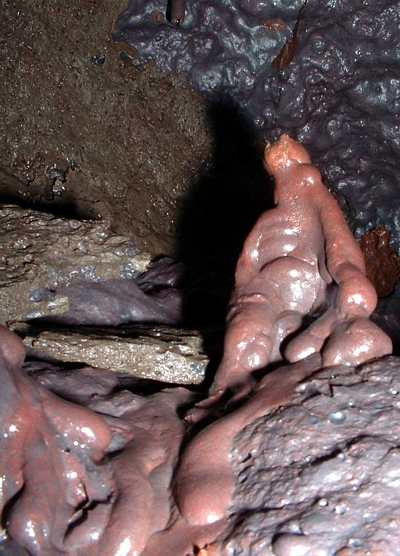 |
John Pint
